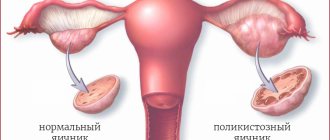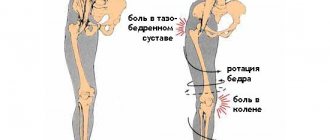Metabolic syndrome is a combination of obesity, arterial hypertension and increased blood glucose due to an impaired response to insulin, the predominance of “bad” cholesterol over “good” cholesterol. The danger of this pathology is that patients develop coronary heart disease, type 2 diabetes, heart attack, and stroke. Risk factors include poor nutrition, low physical activity, family history, and menopause.
Symptoms are deposition of fat mainly on the abdomen, weakness, fatigue, aggression, bad mood, headache, trembling of hands when hungry, a tendency to overeat and eat fatty, sweet foods. The main diagnostic criterion is that a man’s waist circumference is more than 102 cm, and for women – from 88 cm.
For treatment, fractional meals based on vegetables, lean meat and fish are prescribed; cereals, bread are limited, alcohol, sugar and flour, sausage, and semi-finished products are prohibited. Physical activity is needed every day - at least 30 minutes of brisk walking.
What is metabolic syndrome
Metabolic syndrome is, in simple terms, a combination of obesity, high blood pressure (hypertension), high cholesterol and high blood sugar. Metabolism is the name given to metabolism in the body, and this complex of diseases is also called dysmetabolic syndrome, which emphasizes the presence of metabolic disorders.
According to the World Health Organization, the number of patients in Europe alone is about 60 million people; in the USA, after 50 years, 45% suffer from metabolic disorders. Attention to these metabolic disorders is due to the fact that the presence of the syndrome increases the risk of stroke by 7 times and myocardial infarction by 5 times.
Obesity and metabolic syndrome are most common among men from 40 to 65 years old, and in women the incidence increases sharply (5 times) after menopause. In recent years, these metabolic disorders have become increasingly identified among children, adolescents, and young people.
Although clear criteria have been developed for diagnosing metabolic syndrome, it is not a separate disease, and therefore is not included in the International Classification of Diseases (ICD). Most often, patients are given 4 diagnoses simultaneously:
- obesity,
- arterial hypertension,
- cardiac ischemia,
- diabetes mellitus type 2.
Each of them has serious health consequences, and when combined, the risk of death from acute circulatory disorders of the heart and brain increases. One of the figurative names for metabolic syndrome is the deadly quartet.
Pathophysiology
The pathophysiology of metabolic syndrome includes a number of metabolic disorders, but they are based on insulin resistance. It means that the main target cells for insulin (muscle and liver, fat) do not respond to the release of this hormone from the pancreas. Therefore, glucose cannot penetrate inside, tissues suffer from energy deficiency, and there is a lot of sugar in the blood, which provokes even more insulin formation.
The second important factor is obesity and atherogenic (causing atherosclerosis) metabolic imbalance. Patients are characterized by accumulation of fat in the abdominal area. This is usually combined with fat deposits around the internal organs (visceral fat). Such adipose tissue has independent hormonal activity; it increases insulin resistance and a reduced response to the satiety hormone leptin.
Patients suffer from both fat and carbohydrate metabolism:
- blood glucose is constantly elevated;
- higher than normal content of free fatty acids;
- The level of “bad” cholesterol (low and very low density lipoproteins, triglycerides) increases and the level of “good” cholesterol (high density lipoproteins) decreases.
In the liver, due to an impaired response to insulin, the formation of glycogen (glucose stores) is reduced, and new sugar molecules are formed instead. Fat accumulates in the liver cells and pancreatic tissue (steatosis), which further impairs their function.
Spasm predominates in the vascular bed, and the inner lining is injured by increased glucose levels. Therefore, atherosclerotic changes in the arteries progress, and blockage with cholesterol plaques occurs more often. In hypertensive patients with metabolic disorders, the vessels of the eyes, brain and kidneys are affected earlier.
Notes
- Disease ontology database (English) - 2020.
- Monarch Disease Ontology release 2018-06-29sonu - 2018-06-29 - 2018.
- N. M. Kaplan.
The deadly quartet. Upper-body obesity, glucose intolerance, hypertriglyceridemia, and hypertension // Archives of Internal Medicine. — 1989-07-01. - T. 149, issue. 7. - pp. 1514–1520. - doi:10.1001/archinte.149.7.1514. (unavailable link) - Ford ES, Giles WH, Dietz WH
Prevalence of metabolic syndrome among US adults: findings from the third National Health and Nutrition Examination Survey (English) // JAMA: journal. - 2002. - Vol. 287, no. 3. - P. 356-359. - doi:10.1001/jama.287.3.356. - PMID 11790215.
Metabolic syndrome: treatment
Treatment of metabolic syndrome includes several areas, they are all equally important:
- lifestyle changes;
- body weight loss;
- treatment of carbohydrate and fat metabolism disorders;
- normalization of blood pressure.
Restoring disorders with lifestyle changes
Lifestyle changes are considered the basis for the successful treatment of metabolic disorders; it primarily involves nutritional correction:
- Fasting is contraindicated - it leads to pressure surges, depression, and diet failure;
- meals are frequent and divided - three main meals and three snacks, you can’t eat anything between them, you can eat the last time 1.5 hours before bedtime;
- total calorie content up to 1800 kcal (calculated individually based on energy consumption);
- the basis of the diet is vegetables (cabbage, zucchini, eggplant, cucumbers, tomatoes, sweet peppers, green beans), raw carrots;
- you can include in the menu 1% kefir, 1.5% milk, cheese up to 30%, tofu, 5% cottage cheese, herbs, lean meat and fish, 1-2 egg whites;
- allowed in minimum quantities - 1 potato, half a beet, unsweetened fruits (apples, kiwi, citrus fruits) up to 2 pieces, vegetable oil 1 tablespoon, legumes 4 tablespoons, porridge and pasta up to 6 tablespoons, rye bread 2 slices, tablespoon spoon of nuts (seeds), 1 teaspoon of salt;
- alcohol, butter, cream, fatty meat, sausages, canned meat and fish, semi-finished products, honey, jam, sugar, bananas, grapes, dried fruits, confectionery, ice cream, sweet drinks are prohibited.
Every day you need to walk at a fast pace for 30 minutes and take 5-7 minute breaks every hour to warm up during sedentary work. Smoking cessation is required. It is very important to understand that metabolic disorders always have a continuously progressive course, therefore diet and physical activity are prescribed on a lifelong basis.
Without them, no drugs give results. If metabolic syndrome fails to reduce body weight, then to prevent acute circulatory disorders, the patient is prescribed surgical treatment for obesity. Surgeries are performed to reduce the volume of the stomach.
Drugs according to the protocol
If changes in diet and physical activity are not enough to reduce body weight, then the metabolic syndrome treatment protocol uses two registered active ingredients:
- orlistat - Orsoten, Listata, Xenical, Xenalten, Orlistat-Akrikhin;
- sibutramine – Goldline, Reduxin.
Metformin is used to treat carbohydrate metabolism disorders; it has been proven that its use reduces the risk of death from heart attack and stroke by almost 40%. It can be recommended for prediabetes and overt diabetes mellitus type 2; it acts on the main mechanisms of the development of metabolic syndrome:
- increases tissue response to insulin;
- suppresses the formation of new glucose;
- reduces the amount of “excess” insulin in the blood;
- suppresses fat oxidation and the formation of free fatty acids;
- normalizes cholesterol and lipoprotein levels;
- helps reduce blood pressure;
- stimulates weight loss through diet and physical activity.
Other drugs can also be used, but they are usually prescribed for obvious type 2 diabetes mellitus and when Metformin is insufficiently effective: Glucobay, Diabeton, Diaglinide.
For high blood pressure, Enap, Lisinopril, Bisoprolol, Norvasc are used. If a diet limiting animal fat does not lead to a decrease in “bad” cholesterol, then Crestor and Rosucard are recommended.
Therapy with folk remedies
Folk remedies in the treatment of metabolic syndrome have only an auxiliary role; they do not replace medications, but can be used in between main courses or in addition to medications. The following herbs are used:
- appetite suppressants - birch leaf, milk thistle fruits, garcinia, fireweed, alfalfa;
- increasing the response to insulin - bay leaf, arnica, sage, ginger, arnica;
- stimulate the transition of glucose from the blood into cells - beans, galega, blueberries;
- those that excrete sugar in the urine - knotweed, horsetail, lingonberry leaf;
- containing inulin (plant insulin) – chicory root, dandelion, elecampane rhizome;
- fat-breaking agents - blackberry leaf, coltsfoot grass, clover flowers;
- blood pressure - motherwort, skullcap, astragalus.
Select one or two plants in equal parts depending on the predominant symptom. The herb is poured with boiling water at the rate of 1 tablespoon per 300 ml of boiling water, kept in a water bath for 15 minutes, filtered and taken half a glass half an hour before meals 3 times a day. The course of treatment lasts 1.5 months, then after a 2-week break it can be repeated.
Bariatric surgery
For obesity with a high risk of vascular complications and the inability to achieve significant weight loss, the doctor may recommend surgery. Its type is selected individually; the main ones include restrictive and bypassing.
The first are aimed at reducing the volume of the stomach, which helps reduce the amount of food consumed until a feeling of fullness appears. The second type involves a decrease in the area of the small intestine, which reduces the area of nutrient absorption.
In some cases, combined methods are used. Surgeries are contraindicated in cases of severe vascular diseases of the heart, brain, alcoholism, or exacerbation of inflammation of the digestive system.
Treatment of the disease
Treatment of metabolic syndrome is conservative but comprehensive, aimed at:
- normalization of body weight;
- blood pressure stabilization;
- restoration of hormonal levels.
The main therapeutic areas are medication and diet for metabolic syndrome.
To relieve insulin resistance, doctors prescribe:
- biguanides;
- alpha-glucosidase inhibitors;
- Thiazolidinediones.
Drug control of obesity involves the use of lipase inhibitors. Treatment of arterial hypertension is carried out using:
- angiotensin-exceeding enzyme inhibitors;
- beta blockers;
- angiotensin-2 receptor blockers;
- calcium antagonists;
- diuretics;
- imidazoline receptor antagonists.
High cholesterol levels are treated with triglycerols, statins and fibrates.
The metabolic syndrome diet has the following rules:
- frequent food consumption, but in small portions;
- complete exclusion from the menu of fast food, easily digestible carbohydrates and foods high in fat;
- increasing the consumption of vegetables and fruits in any form;
- enriching the diet with cereals;
- limiting daily salt intake to 5 grams;
- preparing food by boiling, stewing, steaming or baking.
In addition, treatment for metabolic syndrome includes:
- regular moderate physical activity;
- psychotherapeutic support;
- the use of traditional medicine recipes, but only after the approval of the attending physician.
Causes of metabolic syndrome in women and men
According to the latest scientific data, the main cause of metabolic syndrome in men is obesity due to overeating, poor nutrition, and alcohol consumption, while in women type 2 diabetes and menopause come first. All of them trigger the main mechanism for the development of metabolic syndrome – insulin resistance.
Risk factors for the disease
The risk factors for metabolic syndrome and its main development mechanism, insulin resistance, have been well studied:
- eating high-calorie foods;
- a diet high in fatty meats and “fast food”;
- addiction to sweets;
- the use of strict diets with a sharp restriction of calories (the body adapts to the lack of energy, stores fat in reserve);
- passive rest, lack of active movements;
- “eating” stress, eating sweet and fatty foods at night;
- hereditary predisposition to obesity, hypertension, atherosclerosis, diabetes;
- uric acid metabolism disorders - gout, uric acid diathesis;
- hypertonic disease;
- frequent stress;
- menopause;
- polycystic ovary syndrome;
- low testosterone levels in men;
- chronic kidney and liver diseases;
- snoring, sleep apnea (obstructive sleep apnea syndrome);
- long-term inflammatory processes in the body;
- uncontrolled use of hormonal drugs.
Causes
Metabolic syndrome is a dangerous disease that, in the absence of comprehensive treatment, causes the development of concomitant pathologies and a rapid deterioration in the patient’s well-being. MS is characterized by increased levels of cholesterol and triglycerides in the blood, which is associated with abnormal metabolism.
The patient's condition worsens due to excess uric acid and hormonal imbalance. All these changes in the body provoke an increase in blood pressure, the development of obesity and the occurrence of disturbances in the functioning of the cardiovascular system.
MS progresses rapidly, as due to poor nutrition and a sedentary lifestyle, cells lose their sensitivity to insulin.
Endocrinologists were able to identify the main reasons that provoke the development of metabolic syndrome:
- Insufficient physical activity, which causes a slowdown in metabolic processes.
- Excessive consumption of fatty, sweet foods. For this reason, a large amount of fatty acids and glucose enters the blood, which do not have time to be absorbed by the body and are deposited in the form of excess weight, which is why obesity develops.
- Long-term adherence to a low-calorie diet leads to metabolic disorders. The body stores adipose tissue, which makes glucose much less absorbed by internal organs.
- Genetic predisposition to MS. Metabolic syndrome has a hereditary predisposition. The rapid development of the disease is associated with mutations of certain genes.
- Arterial hypertension. If a patient ignores the disease for a long time, then he will face a deterioration in blood flow in tissues and internal organs, which can lead to the development of cell insensitivity to insulin.
- Obstructive apnea syndrome. This pathology is characterized by snoring and short-term cessation of breathing during sleep. If the disease is associated with impaired nasal breathing, then hypoxia will contribute to the development of hormonal disorders, which is why, with a 95% probability, the patient will develop metabolic syndrome.
- Some medications can cause cell insensitivity to insulin. For example, thyroid-stimulating hormones, corticosteroids, oral contraceptives.
- Metabolic syndrome can develop in women after menopause. This is due to a natural decrease in estrogen production.
- Prolonged psychological stress and frequent stressful situations disrupt the production of hormones, which negatively affects the body's sensitivity to insulin.
Most often, metabolic syndrome develops against the background of physical inactivity in combination with frequent consumption of food that contains large amounts of carbohydrates. To effectively combat excess weight and normalize the functioning of internal organs, the patient must undergo a comprehensive examination of the body in a timely manner so that the endocrinologist can correctly determine the diagnosis and prescribe the appropriate treatment.
Why does metabolic syndrome occur in children?
The prevalence of metabolic syndrome in children is associated with obesity. It develops when the calorie content of food exceeds energy expenditure. If two parents have obesity, the risk increases to 80%; if only one has obesity, then it is 40-50%. Often, weight gain occurs from birth when feeding high-calorie formulas and constant overfeeding.
Most obese children's diet is dominated by flour products, sweet soda, chips, juices, and they spend most of their time at the computer, doing homework, and not playing sports. Sometimes the provoking factor is severe stress or a severe infection.
Symptoms, signs and criteria of metabolic syndrome
Symptoms of metabolic syndrome include signs of:
- obesity - the predominant deposition of fat on the abdomen, but it is also visible on the chest, upper third of the body; with sudden weight gain, stretch marks appear on the abdomen and hips;
- hypertension – headache, nausea, dizziness;
- autonomic reactions - redness of the neck and chest, hot flashes, sweating, rapid pulse, trembling hands, dry mouth;
- lack of glucose in cells - weakness, depressed mood, fatigue, aggression during breaks in meals, addiction to sweets;
- increased cholesterol and atherosclerosis - heart pain, palpitations.
In women, against the background of a decrease in female hormones, there is an increased reaction of the skin to testosterone - acne, hair loss, greasiness of the face, increased hair growth on the extremities.
During the childbearing period, metabolic syndrome often causes infertility. In men, potency decreases and sexual disorders develop. As diabetes and atherosclerosis progress, the vessels of the eyes and kidneys are damaged, causing stroke and heart attack.
The criteria for metabolic syndrome include one main and 2 additional ones. The main sign in a man is a waist circumference greater than 102 cm and from 88 in women. Additional:
- blood pressure is equal to or higher than 140/90 mmHg. Art. (or the patient is taking drugs to reduce);
- disorders of fat metabolism according to the lipid profile (in mmol/l) - triglycerides from 1.7 and/or low-density lipoproteins from 3, high-density lipoproteins - below 1.2 in men, to 1 in women;
- impaired tolerance (glucose resistance) according to the glucose tolerance test (in mmol/l) – fasting sugar 6.1-7 and/or 2 hours after sugar load 7.8-11.1.
Formulation of diagnosis
There is no diagnosis of “metabolic syndrome” in ICD-10. Only essential hypertension (hypertension) - code I10 and obesity - code Ε66.9 are classified. The diagnosis may have double coding (I10 and Ε66.9); Depending on the prevalence of one or another code, it is placed in first place. Diagnostic reports describe all components of this symptom complex.
Considering that increased blood pressure in MS is a consequence of abdominal obesity, insulin resistance and hyperinsulinemia, hypertension is secondary and symptomatic, except in cases where hypertension occurred before the onset of signs of MS.
Examples of diagnostic reports
- Diagnosis: stage I obesity. Impaired glucose tolerance. Arterial hypertension 2 degrees, risk 2 (moderate).
- Diagnosis: stage III obesity. Dyslipidemia. Impaired glucose tolerance. Hyperuricemia. Arterial hypertension stage 1, risk 3 (high).
- Diagnosis: stage II obesity. Hypertriglyceridemia. Hyperglycemia on an empty stomach. Hyperuricemia. Arterial hypertension grade 3, risk 4 (very high).
- Diagnosis: stage II obesity. Dyslipidemia. Arterial hypertension grade 3, risk 4 (very high).
- Diagnosis: stage I obesity. Dyslipidemia. Impaired glucose tolerance.
- Diagnosis: stage II obesity. Severe obstructive sleep apnea syndrome. Impaired glucose tolerance. Arterial hypertension 2 degrees, risk 2 (moderate).
- Diagnosis: Stage II hypertension. Degree of hypertension 3. Dyslipidemia. Left ventricular hypertrophy. Risk 4 (very high). Obesity II degree. Impaired glucose tolerance.
- Diagnosis: Stage III hypertension. Degree of hypertension 3. Dyslipidemia. Left ventricular hypertrophy. Risk 4 (very high). Obesity II degree. Moderate obstructive apnea syndrome. Impaired glucose tolerance.
Diagnosis of the disease
Diagnosis of metabolic syndrome is carried out by an endocrinologist, for this it is necessary:
- weighing, measuring waist circumference;
- determination of blood pressure (one-time and monitoring throughout the day);
- biochemical blood test - cholesterol, uric acid and glucose;
- lipid profile (blood fats);
- glucose tolerance test (measuring glucose on an empty stomach and 2 hours after exercise);
- blood insulin, C-peptide (insulin precursor), leptin (leptin resistance often occurs);
- ECG (standard and with stress);
- Ultrasound of the liver and kidneys, pancreas.
Differential diagnosis (difference from other diseases) is carried out with the syndrome, Itsenko-Cushing's disease using a test with Dexamethasone, tomography of the brain, adrenal glands, and a urine test for cortisol. If the doctor suspects diseases of the thyroid gland or ovaries, then an additional test of pituitary hormones (corticotropin, thyrotropin, follitropin, lutropin), thyroxine is prescribed.
Screening for the presence of metabolic syndrome is recommended for all patients who are overweight, especially in combination with high blood pressure and pain in the heart. Also, gynecologists often check its presence in case of polycystic ovary syndrome and infertility, and refer the woman for a consultation with an endocrinologist.
Differential diagnosis
Abdominal obesity, hypertension and metabolic disorders of carbohydrates and fats, characteristic of MS, are observed in Cushing's disease and syndrome. Even the appearance of patients with MS and Itsenko-Cushing's disease is often identical, which requires differential diagnosis.
For differential diagnosis with one or another endocrine disease that occurs with a clinical picture similar to MS, it is necessary to use additional research methods.
Computed tomography of the adrenal glands will allow you to establish or exclude their primary pathology. or nuclear magnetic resonance imaging of the pituitary gland will help assess its functional and structural state and determine the presence or absence of micro- or macroadenomas. Itsenko-Cushing's disease is characterized by the presence of a pituitary tumor and bilateral adrenal hyperplasia. Itsenko-Cushing syndrome may be associated with unilateral damage to the adrenal glands (corticosteroma, adenocarcinoma of the adrenal cortex).
Hormonal research methods can provide additional assistance in differential diagnosis. For this purpose, the blood levels of cortisol, aldosterone, ACTH, prolactin, thyroid-stimulating hormone, etc. are determined. Patients with MS may also experience a slight increase in the levels of cortisol, prolactin, thyroid-stimulating hormone, ACTH, but with primary endocrine pathology, the excess concentration of these hormones will be in tens and hundreds of times more than normal values. If the presence of aldosteroma is suspected, determination of aldosterone and renin levels will help in differential diagnosis. The detection of pheochromocytoma will be facilitated, along with CT of the adrenal glands and para-aortic region, by the study of catecholamines in the blood and urine and vanillyl-mandelic acid in the urine, especially in the period after a hypertensive crisis.
It is not often possible to determine the organic cause of obesity. Only in 1 out of 1 thousand patients can a disease leading to an increase in BW be detected. However, a thorough examination of patients to determine the possible cause of obesity is necessary, since this greatly influences treatment tactics.
Recommendations for the prevention of metabolic syndrome
To prevent metabolic syndrome and its complications, it is recommended:
- a diet with sufficient amounts of plant foods and low-fat animal products;
- do not use monotonous diets with a sharp restriction of calories to lose weight; if it is difficult to create a diet, you need to consult a nutritionist;
- control of caloric intake;
- eating in frequent and fractional quantities;
- quitting smoking and alcohol;
- adherence to daily routine;
- sufficient duration of sleep at night, contact an ENT doctor if you snore;
- avoidance of stressful conditions, the ability to relieve their consequences using relaxation techniques (breathing exercises, yoga, meditation);
- do not use drugs for self-medication; special care should be taken when using hormones.
Every day you need to make time for physical activity. It not only helps burn calories, but also increases the sensitivity of muscle tissue to insulin. Any type of exercise is suitable - walking, swimming, dancing, running. It is important to try to increase physical activity in everyday life - for example, preparing food while standing, climbing stairs, and not using the elevator.
To speed up blood circulation in the muscles, massage and self-massage are used. For preventive purposes and to consolidate the effect of weight loss, physiotherapy is used: myostimulation, cryosauna, carbon dioxide, salt baths.
Metabolic syndrome includes obesity, hypertension, impaired carbohydrate and fat metabolism. Treatment requires lifelong diet and physical activity to lose weight and reduce insulin resistance. They are supplemented with medications, and if they are insufficiently effective, surgery is performed.
Prevention of metabolic disorders
It is impossible to eliminate the genetic cause of metabolic pathology. But you can influence the risk factors for developing the disease.
Increased insulin resistance leads to:
- sedentary lifestyle;
- excess body weight;
- excessive caloric content of food;
- chronic stress;
- smoking.
To prevent metabolic syndrome, men and women are recommended the following correct lifestyle:
- rejection of bad habits;
- balanced diet;
- dosed physical activity.
It is especially important to maintain body weight within normal limits. Body mass index is used to detect obesity. This parameter is calculated using a special formula. Normally, the index does not exceed 25 kg/m2.
If a patient is diagnosed with obesity, then he needs to count calories in his diet, limit fatty and sweet foods, and regular exercise.
Sometimes getting rid of extra pounds is very difficult. If lifestyle modification does not produce visible results, then obesity is treated with medications or surgery.












